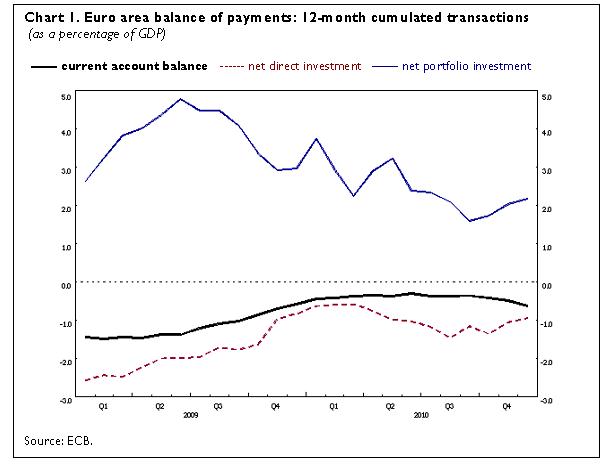Euro area balance of payments (December 2010 and preliminary overall results for 2010 as a whole)
In December 2010 the seasonally adjusted current account of the euro area recorded a deficit of EUR 13.3 billion. In the financial account, combined direct and portfolio investment recorded net inflows of EUR 57 billion (non-seasonally adjusted).
In 2010 as a whole, the seasonally adjusted deficit for the euro area current account amounted to EUR 56.4 billion (around 0.6% of GDP), compared with a deficit of EUR 51.4 billion in 2009. Combined direct and portfolio investment recorded net inflows of EUR 111 billion in 2010, compared with net inflows of EUR 190 billion in 2009, mainly as a result of lower net purchases of euro area debt securities by non‑resident investors.
Current account
The seasonally adjusted current account of the euro area recorded a deficit of EUR 13.3 billion in December 2010 (see Table 1). This reflected deficits in current transfers (EUR 8.2 billion), income (EUR 4.4 billion) and services (EUR 1.1 billion). The goods account was close to balance.
According to the preliminary results for 2010 as a whole, the seasonally adjusted current account recorded a deficit of EUR 56.4 billion (around 0.6% of euro area GDP – see Table 1 and Chart 1), compared with a deficit of EUR 51.4 billion in 2009 (also around 0.6% of euro area GDP). This increase resulted from a decrease in the goods surplus (from EUR 37.0 billion to EUR 20.8 billion) and an increase in the current transfers deficit (from EUR 92.6 billion to EUR 100.7 billion), which were partly offset by a decrease in the income deficit (from EUR 28.0 billion to EUR 9.4 billion). The services surplus remained broadly unchanged.

Financial account
In the financial account (see Table 2), combined direct and portfolio investment recorded net inflows of EUR 57 billion in December 2010 as a result of net inflows in portfolio investment (EUR 38 billion) and in direct investment (EUR 19 billion).
The net inflows in direct investment resulted from net inflows in equity capital and reinvested earnings.
The net inflows in portfolio investment were mainly accounted for by net inflows in debt instruments (EUR 46 billion), which were partly offset by net outflows in equity (EUR 9 billion). The net inflows in debt instruments resulted both from net purchases of euro area bonds and notes by non-residents and from net sales of foreign bonds and notes by euro area residents.
The financial derivatives account recorded net inflows of EUR 3 billion.
Other investment recorded net outflows of EUR 49 billion, reflecting net outflows in MFIs excluding the Eurosystem (EUR 70 billion) and other sectors (EUR 4 billion), which were partially offset by net inflows in general government (EUR 19 billion) and in the Eurosystem (EUR 6 billion).
The Eurosystem’s stock of reserve assets decreased from EUR 597 billion to EUR 591 billion in December 2010, mainly on account of valuation effects (with transactions contributing to an increase of EUR 1 billion in the overall reserve assets position).
In 2010 as a whole, combined direct and portfolio investment recorded cumulated net inflows of EUR 111 billion, compared with net inflows of EUR 190 billion in 2009. This decrease was largely the result of lower net inflows in portfolio investment (down from EUR 265 billion to EUR 197 billion), which in turn reflected mainly lower net purchases of euro area debt securities by non-resident investors.
Data revisions
This press release incorporates revisions to the data for November 2010. These revisions have not significantly altered the figures previously published for the current and capital accounts. The financial account was revised mainly on account of revisions to net inflows in portfolio investment (up from EUR 13 billion to EUR 26 billion) and to net outflows in other investment (up from EUR 24 billion to EUR 38 billion).
Additional information on the euro area balance of payments and international investment position
In this press release, the seasonally adjusted current account refers to working day and seasonally adjusted data. Data for the financial account are non-working day and non-seasonally adjusted.
In line with the agreed allocation of responsibilities, the European Central Bank compiles and disseminates monthly and quarterly balance of payments statistics for the euro area, whereas the European Commission (Eurostat; see new releases for “Euro-indicators”) focuses on quarterly and annual aggregates for the European Union. These data comply with international standards, particularly those set out in the IMF’s Balance of Payments Manual (fifth edition). The aggregates for the euro area and the European Union are compiled consistently on the basis of transactions and positions with residents of countries outside the euro area and the European Union respectively.
A complete set of updated euro area balance of payments statistics (including a quarterly geographical breakdown by main counterparts) and international investment position statistics is available in the “Statistics” section of the ECB’s website under the headings “Data services”/“Latest monetary, financial markets and balance of payments statistics”. These data, as well as historical euro area balance of payments time series, can be downloaded from the ECB’s Statistical Data Warehouse (SDW). Data up to December 2010 will also be published in the March 2011 issues of the ECB’s Monthly Bulletin and Statistics Pocket Book. Detailed methodological notes are available on the ECB’s website. The next press release on the euro area monthly balance of payments – taking into account the enlargement of the euro area to include Estonia on 1 January 2011 – will be published on 18 March 2011.
Annexes
Table 1: Current account of the euro area
Table 2: Monthly balance of payments of the euro area
Banco Central Europeo
Dirección General de Comunicación
- Sonnemannstrasse 20
- 60314 Frankfurt am Main, Alemania
- +49 69 1344 7455
- media@ecb.europa.eu
Se permite la reproducción, siempre que se cite la fuente.
Contactos de prensa

